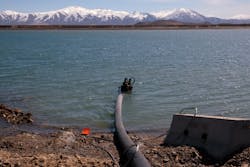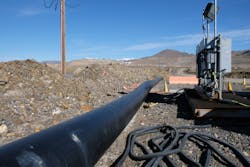Nevada Mining Company Installs Tsurumi Pumps
Water plays a critical role in the gold mining process. Supplying water to the mill process consistently on a daily basis is an important factor in keeping the mine production flowing. One of the largest gold mining companies in Nevada was experiencing pump breakdowns during its operation, ceasing work while the company worked to make repairs. The stoppage was costly for the mine, averaging about $40,000 to $50,000 each time. Also, the fix usually only lasted about a month to three months total, which caused the mining company to lose money.
The mining company repaired its pumps numerous times, and after realizing how much downtime it was experiencing, it thought the issue was due to faulty repairs. The mine management eventually turned to the experts at Tech-Flow, a nearby Tsurumi Pump distributor and equipment service company, to handle the next round of repairs.
After completing many repairs, the mining company grew confident in the work that Tech-Flow was doing and asked the distributor to do an analysis of the job site to see if they could improve the performance and life cycle of the mine’s submersible pumps. What Jace Church, territory sales manager at Tech-Flow, found is that it was not faulty repairs that were the problem. Tech-Flow proved the original pump selection and installation to be the purpose of the continuous failures.
Instead of continuing the pattern of repairing the pumps often, the mining company trusted Tech-Flow’s advice on an alternate solution. Based off a recommendation from Church and Jeff Davis, regional sales manager at Tsurumi Pump, the mining company chose to replace the pumps with pumps more suitably designed for this application, the Tsurumi GSZ-150 Electric Submersibles.
Tech-Flow often found cavitation issues with the previous pumps’ impellers, and they concluded that one of the factors causing failures was the improper installation and submergence level of those units. The new installation of the Tsurumi units implemented proper submergence to mitigate the possibility of cavitation. This Tsurumi model also features a cooling jacket over the motor to prevent overheating in case the pump needs to run when it is not totally submerged. The impeller on the GSZ-150 is made with a durable, high chrome impeller and is designed for more efficient water transfer than the solids handling wastewater style units, which were originally installed. Both the impeller and cooling jacket ensure that the pump can withstand the tough working conditions on the job site and remain operating longer.
“The water level often varies in the retention pond that the mine pumps its water from, so we chose a pump that is able to adapt to the changes,” Church said. “Also, we needed to ensure that the pump could handle the flow rate of the one-mile long pipe system of getting the water from the retention pond to the mill.”
The system is operating at 110 to 120 feet of head, pumping between 2,200 to 2,600 gpm. The switch to the Tsurumi pumps was made in August 2018, and they operate intermittently on the job site, between 75 to 90% of the time.

